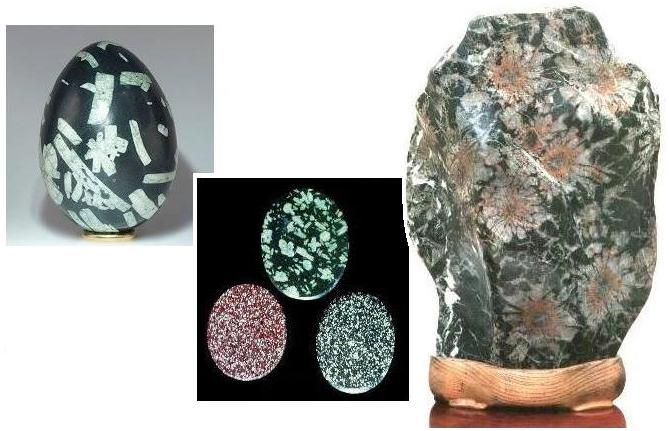( Fr-
porphyre;
Ger- Porphyr; Nor- porfyr; Rus- ![]() )
)
PORPHYRY (See also LEOPARDITE & LEOPARD ROCK
entry.)

A. Porphyry. "Chinese writing stone
[or rock]" (height of egg - 6.1 cm) from unspecified locality in
California. Claude
Pelisson's collection. (© photo
by Claude Pelisson)
B. Porphyry. Diverse porphyries from Egypt, Italy and Rumania fashioned as cabochons (greater axes - ca. 3.5 cm). Smithsonian Institution collection. (photo by L. Bolton)
C. Porphyry simulant. Kikkaseki, "stone/rock of chrysanthemum flower" (height - 36 cm), a metamorphic rock that contains radial clusters of carbonate crystals (dolomite, calcite or aragonite) from Gifu Prefecture, central Japan. (© photo courtesy by Nobuo Ishihara)
DESCRIPTION: Porphyry is the term
geologists apply to igneous rocks that consist of relatively large
grains or crystals, called phenocrysts,
surrounded by a finer grained
material, usually
called the groundmass.
Porphyries may be of just about any
composition known for igneous rocks, and the groundmasses may be
phaneritic, aphanitic, or even glass.
Colors - phenocrysts, which may or many not
contrast markedly with the overall color of their surrounding
groundmasses, may be virtually colorless, white, black or just about
any color.
H. (effective hardnesses of most porphyries)
6 - 7
S.G. 2.5 - 4
Light transmission
- opaque except for those with glass groundmass, which may be
subtransparent or translucent in thin pieces
Luster -
rough, typically dull
Breakage -
irregular.
OTHER NAMES: Names for porphyries given by geologists in the field usually include three elements: 1.a geographical name indicating where the rock occurs; 2.its igneous rock name on the basis of its overall compostion and grain size; and 3.the word porphyry -- e.g., the Mount Rogers rhyolite porphyry of Grayson County, southwestern Virginia. Unfortunately, however, many porphyries have been recorded in the literature with no indication as to their overall composition – e.g., the Uncle Sam Porphyry that crops out on Uncle Sam Hill about 2½ miles southwest of Tombstone, Arizona.
Other names given porphyries include the following:
USES: Cabochons, eggs, spheres, figurines, etc.
OCCURRENCES: Typically as relatively small igneous masses, such as dikes; less commonly in border zones of larger igneous masses.
NOTEWORTHY LOCALITIES: See OTHER NAMES and REMARKS.
REMARKS: The ultimate source of the word porphyry is the ancient Greek word πορφύρεος (O.E.D). The rock that led to this designation probably was the reddish purple porphyry first quarried in Egypt during the Ptolemaic era (323-30 B.C.) that has been referred to variously as porfido rosso antico, porphyrites leptosephos, lapis porphyrites and "The Stone of Rome." It is an altered andesite porphyry that consists of a dark reddish purple aphanitic groundmass plus relatively small white and flesh colored andesine (plagioclase feldspar) phenocrysts. The reddish purple color or the groundmass has been variously attributed to the presence of thulite or of piemontite of the epidote group (and in some literature referred to as withamite). This porphyry, apparently rediscovered by ancient Romans, was actively quarried from a dike on Jebel Dhokan Mountain, central eastern Egypt during Roman times. It has been fashioned into many relatively famous objects, some sculpted as recently as the 18th century A.D. -- The bust of Alexander the Great, now in the Louvre (see Saudi Aramco World, November/December, 2003, p.46) and the head of Hadrian, which is in the British Museum at Bloomsbury, London, England are examples.
A porphyry quarried near the ancient cities of Sparti and Marathonisi, southern Greece that consists of a green groundmass and lighter colored green feldspar phenocrysts was known variously as marmor lacedaemonium viride and perfidio serpentino during the period widely referred to as classical Greek.
The name llanite was given by one of America's famous early petrologists, Joseph Paxton Iddings.
SIMULANTS:
Kikkaseki (stone/rock of chrysanthemum flower) is not a porphyry, as has been reported (e.g., Dietrich, 1989). It is a metamorphic rock that contains clusters of carbonate crystals (dolomite, calcite or aragonite) arranged in radial groups. This rock, a gemrock in its own right, is used as an ornamental rock in Japan, and I am told it has been considered "a natural monument since 1941" (Nobuo Ishihara, personal communication, 1987). - [phenocryst-like masses are largely some carbonate mineral that effervesces with dilute HCl and has an inferior hardness as compared to virtually all typical phenocrysts.].
***Porphyry ware - Wedgewood china colored and patterned to resemble porphyry. - [China can be seen with the naked eye or aided only by a handlens to be a single phase material.].
REFERENCES: No general reference.
R. V. Dietrich © 2015
Last
update: 24 June 2005
web page created by Emmett Mason